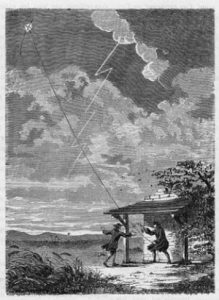


In Philadelphia, he helped launch the city’s first police force, the first volunteer fire company, the first fire insurance firm, the first hospital, the first public library, and the academy that became the first institution of higher learning (the University of Pennsylvania). When Franklin saw that something needed doing, he did it. He developed a network of printing partnerships throughout the American colonies. He started a successful printing business, newspaper, and magazine. He made himself an influential author and editor.
BENJAMIN FRANKLIN KITE EXPERIMENT EXPLAINED HOW TO
He taught himself how to play the guitar, violin, and harp. He took the initiative of learning French, German, Italian, Latin, and Spanish. With less than three years of formal schooling, he taught himself almost everything he knew. Go here to visit all of our Electrical Energy pages.Benjamin Franklin pioneered the spirit of self-help in America.
BENJAMIN FRANKLIN KITE EXPERIMENT EXPLAINED FREE
Unfortunately, from our point of view, he assigned them in the opposite sense to our understanding - "positive" meaning a deficit of free electrons - which is why we now call the electron a negatively charged particle. To these he assigned the names we still use, positive and negative. The single most important discovery noted in these letters is that of polarity, that is, he found that all electrical potentials were not equivalent, but could be observed holding either of two opposite charges. These Letters are the reports of his experiments, of theories he formed to explain the experiments' results, and more speculative theories he extrapolated from his observations and analysis of his findings. The positive and the negative charges helped identify the atmospheric and frictional electricity.īen Franklin is rightly considered the principal founder of the scientific study of electrical phenomena. His experiments became the origin of the "plus" and "minus" nomenclature that are still in use today. Two of his friends got electrocuted while they were working on this, so Franklin decided to do the kite experiment, alone.īen Franklin's experiments on electricity became the foundation of many inventions such as electricity, batteries, incandescent light bulb, electromagnetic fields, generators, transformers and other related items. The story is that he and three of his friends were trying to analyze static electricity and experiment with it. When a thought popped in his head, like lightning is a source of electricity, he had the determination to prove it. The key drew repeated sparks that charged the vial, and all the experiments made yielded electricity.

When his knuckle touched the key, he received a strong spark with an electrifying sensation. The long wait almost made him give up until he noticed loose fibers on the string. Accompanied by his son, Ben Franklin raised the kite while staying under a shed to avoid getting wet. At the top end was an iron point and at the bottom part of the string was a key. To avoid damaging the paper under the rain, he used silk instead of paper. His electricity experiments included an infamous event in the summer of 1752 when he made a kite with silk, which he sent up with a cord made of hemp. With this tube Ben Franklin began a course of electrical experiments which resulted in discoveries which seem to have exerted a larger material influence upon the industries of the world than any other discovery of the human intellect. Collinson, of London, and a member of the Royal Society, a glass tube, with instructions for making experiments with it. Shortly after his return to Philadelphia the Library Company received from Mr. While on a visit to Boston in 1746 Franklin witnessed some electrical experiments performed by a Mr. In 1751 he published his book of electrical current experiments in England. Five years later he sent a letter on it to the Royal Society. His electrical experiments formed the basis for other inventions that we still use today.īenjamin Franklin began working on electricity after he heard a lecture about it in Scotland in 1743. Ben Franklin was a great American inventor and innovator.


 0 kommentar(er)
0 kommentar(er)
